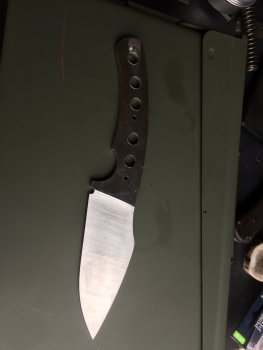Good on ya for choosing 1084 in light of your current equipment status!
1084 is about as foolproof as it gets when it comes to heat treating. This is way oversimplified, but get it hot, quench it in something wet, and you will get a very serviceable blade.

I've reviewed Kevin Cashen's video on heat treating 1084, and would recommend it to anyone! Very well done, and it might even surprise some folks.
So, all that being said, let's talk specifics....
First, getting the most out of a specific steel in a knife blade application, involves MANY more factors than just the heat treat. Think hard about blade geometry first! Then when "working out" the heat treat, remember that you're working out a heat treat that performs the best with the chosen blade geometry.
OK....a step back to numbers/times, etc.
The majority of my grinds are flat, with convex edges, that vary in degree based on the individual blade.... smaller blades have finer geometry.....larger blade have a more coarse geometry.
For the first type, which would be hunter sized blades... from a forged blade aspect:
-After forging, thermal cycle 3X
-After thermal cycle, heat to just critical (I use 1525F) and into the annealing tub/vermiculite
After rough grind, my heat treat consists of.....
Bring blade to 1525F, NO SOAK, and quench in 120-130F pre-heated oil
-Allow blade to cool down IN THE QUENCH, until it can be handled with bare hands.
-Temper: 415F, 3X, 2 hours each time, allowing the blade to cool NATURALLY between temper cycles.
Now, understand, these are the steps that I have developed over time, and were developed to gain the best performance not only from the steel, but from the grinds/geometry that I apply to blades.... but I would recommend the above information as a starting point for anyone venturing into 1084.

